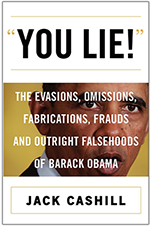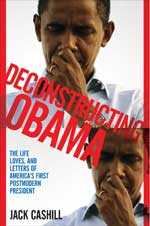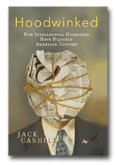What Columbia Missed
In Its Review of Rolling Stone
Get your copy of Jack Cashill's latest book, "You Lie!"

___
Get your copy of Deconstructing Obama

___
Jack Cashill's book:
Hoodwinked: How Intellectual Hucksters have Hijacked American Culture
© Jack Cashill
AmericanThinker.com - April 7, 2015
In November, Rolling Stone magazine ran a story detailing the horrific account of an alleged gang rape at a fraternity on the University of Virginia campus. The story quickly proved to be rubbish, and Rolling Stone reached out to the Columbia University School of Journalism to discover how the magazine could have blundered so badly.
With much ado, Columbia responded. Its 13,000-word report identified problems in “reporting, editing, editorial supervision and fact-checking.” This was all true enough, but Columbia missed the real problem. As I document in my forthcoming book, Scarlet Letters, cases like the Rolling Stone’s have become so common because those perpetrating a given fraud almost inevitably advance causes that the cultural establishment, the Columbia faculty included, wants to see advanced.
Although there are a few exceptions, the people who guard the cultural gates tend to be liberal on sexual and social issues, socialist on economic ones, internationalist in their worldview, and Democratic in their voting preferences. Not unnaturally, they are inclined to promote, praise, and protect those creative individuals who think as they do. This trend dates back to the conscious cover-up of the Soviet terror-famine of the early 1930s by the New York Times’ Pulitzer Prize-winning reporter, Walter Duranty, and reached something of a collective climax with the media coronation of Barack Obama.
Despite its claim to prepare students capable of “finding out the truth of complicated situations,” Columbia’s Journalism School produces students less interested in finding the truth than in finessing it to accommodate this reigning progressive orthodoxy. In this regard, the Columbia J-School hews to the academic norm.
In his 2011 "To Catch a Journalist" series, a take-off on the NBC series "To Catch a Predator", James O’Keefe captured on video several profs at Columbia and NYU confirming our worst suspicions. Most revealing was a presentation to a large lecture hall full of eager NYU students by journalism professor Jay Rosen and his guest, new media guru Clay Shirky. “We are all in this room insiders,” Shirky told the students. “We are the most elite news [creators.]” Rosen added, “We are the one percent.”
As Shirky explained, “Elites are perfectly comfortable with there being information about how they make their decisions and what their biases are, as long as that only circulates among other elites.” In other words, they will try to convince readers and critics of their objectivity, but they need not bother to fool their peers.
Shirky then explained how in 2008 New York Times staffers openly angled to advance the cause of their preferred candidate, either Hillary Clinton or Barack Obama. Republican candidates served no larger purpose than as grist for the journalist snark mill. Said Shirky of Michele Bachmann, for instance, “Crazy stuff comes out of her mouth all the time. . . It’s just insane.” He and the students cheering him on worked under the assumption that all right thinking people were of one mind on the two-party system.
They were of one mind as well on the shooting deaths of Trayvon Martin and Michael Brown, a collective misreporting far more consequential than that of the Rolling Stone rape story. In an earlier piece in American Thinker I singled out NBC’s Lisa Bloom for disinformation honors on the Trayvon story. The daughter of feminist lawyer Gloria Allred, Bloom covered the George Zimmerman trial from gavel-to-gavel. Having written a book on the case called Suspicion Nation, Bloom had no excuse for the mistakes she made, none more egregious than her handling of witness Jonathan Good.
Of all the witnesses to testify at the trial, Good was easily the most coherent and convincing. As Good clearly testified, Zimmerman was the one “yelling out help” while being attacked. It was Good who told the police, “One guy on top in the black hoodie was pretty much just throwing down blows on the guy kind of MMA [mixed martial arts]-style.” When Good testified to the same at the trial, he assured Zimmerman’s acquittal.
Bloom, however, spends only one sentence in her book on Good and gets everything wrong. It reads as follows: “Trayvon remained a threat after the shooting, according to Zimmerman, which is why he asked John Good, the first to come outside after the gunshot, ‘to help me.’” (italics added) A book is not a solitary adventure. A successful one requires an author, an agent, a publisher, an editor, any number of obliging reviewers, and, in some cases, willing allies in the film and broadcast industries. They all let Bloom’s nonsense get by, not because of failures in fact checking, but because of the success of media groupthink.
Having learned nothing from Zimmerman’s acquittal, the media redoubled their folly with the Michael Brown shooting. The New York Times led the way. On August 21, 2014, twelve days after the Brown incident, the Times’ public editor Margaret Sullivan scolded the paper’s reporters for writing that “witnesses have given investigators sharply conflicting accounts of the killing.” Sullivan referred to this an “object lesson in the problems of dubious equivalency.” As Sullivan saw it, the only credible witnesses were those who were reciting the “hands up, don’t shoot” mantra.
For months to come, chastised by their own public editor, the Times’ reporters treated the eyewitness accounts of a meekly surrendering Michael Brown as though they made sense. It was not until March 23, seven full months after her original lament, that Sullivan got around to “ reconsidering my August post .”
She was wrong to dismiss as “ghosts” the witnesses who backed Officer Darren Wilson’s account, she admitted. “Now that the Justice Department has cleared Mr. Wilson in an 86-page report that included the testimony of more than 40 witnesses,” wrote Sullivan in a massive understatement, “it’s obvious to me that it was important to get that side of the story into the paper.” You think?
“What DOJ found made me ill,” echoed the Washington Post’s Jonathan Capehart in a March 16 piece titled, “‘Hands up, don’t shoot’ was built on a lie.” Capehart, who had blown off the November grand jury findings, had to concede that “the popular hands-up storyline” was perpetuated exclusively by Brown’s partner in crime, Dorian Johnson. The unpaid bloggers at the Conservative Treehouse were reporting this in August. They had quickly and accurately pierced the media’s ideological smokescreen just as they had earlier done in the Martin case. The media refused to examine the evidence the Treehouse compiled. It did not fit the pre-written script.
The Capehart mea culpa came too late. "After my piece,” wrote Capehart, “folks used Twitter and Facebook to dismember my personhood. Fellow African-Americans called me a sellout or 'house negro.'” They preferred the story that he and his colleagues had been telling since Trayvon got shot more than three years ago. It’s too bad Columbia U. did not got involved on that one. Even when outraged, feminists won’t burn a city down.


